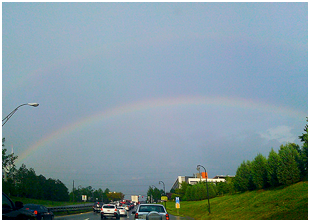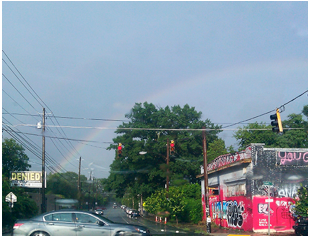On August 2nd, Dr. Jerry Cullum gave a curator’s talk for the exhibition “From Cosmology to Neurology and Back Again” which showed at whitespace from July 6 – August 5, 2012. In this exhibition, Dr. Jerry Cullum carefully connected the works of twenty-two international and local artists exploring the ways in which cognitive sciences drive the discussion about the nature of investigation in the sciences and humanities and the resulting impact on artists. One of the artists included in the exhibition was Atlanta-based artist, Julie Sims, who has composed this short essay on her experience of “From Cosmology to Neurology and Back Again.”
♦ Check out this video of the Curator’s talk and images of the exhibition for reference provided by Julie Sims
A Rainbow Unwoven: The End is the Beginning
I arrived at Whitespace in a torrential downpour bracketed by an amazing double rainbow. It filled the sky in the east, and coming down Edgewood Avenue it appeared to spring directly from the gallery itself. Despite a general lack of superstitious belief, it was difficult not to regard this as a portent relevant to the curator talk for From Cosmology to Neurology and Back Again that was taking place within. Could there be a more symbolically appropriate coincidence? And was the fact that I was unable to help myself from interpreting it as such not also both appropriate and ironic?
A rainbow is never located at a single, fixed point of perception—its position is always relative to the viewer.
Now, strike “a rainbow” from that sentence and replace it with “reality.”
Now, strike the word “reality” from that sentence and replace it with “a work of art.”
A work of art is one person’s interpretation of reality. Curated art creates a second layer of interpretation in response to the first. The viewer forms yet another layer of response to both of those interpretations in dialog with one another. From Cosmology to Neurology and Back Again is a show about perception and connection, but how each viewer interprets the questions and the answers he or she perceives is complicated by the very perceptual problems the show is about. Any attempt to chase an apparent end moves it ever further beyond our grasp. Only if we can rise above our horizons do we become aware that the ideas in the show are like rainbows when seen from high altitude, and actually form a circle in which no end or beginning can be found.
Myths, like works of art, are stories we tell ourselves about the world in an attempt to make sense of things. The appearance of rainbows transcends all times and cultures, and they are explained by many different myths. In Western culture they are generally seen as a message of hope, due to the influence of the Judeo-Christian story of the great flood, after which it is said that God sent the sign of a rainbow as a promise that water would never again wipe out all life.
This was of some consolation while wading through ankle-deep water to the gallery, at least until the discussion about certain artworks on view reminded me that there had been somewhat inconsistent application of that promise, and further references to rising sea levels pointed out that we were also never promised we wouldn’t be allowed to wipe ourselves out. The presence of water was as pervasive throughout the works in the show as it was in the air outside, where it was busy splitting rays of light into a spectrum.
In fact, rainbows permit us to see that which we otherwise cannot—the individual wavelengths of light. The title of this essay refers to John Keats’ assertion that scientific explanations for the existence of rainbows had stripped the poetry from them, which illustrates how we tend to limit our imagination to comfortable confines—without even realizing we have done so. The invisible made visible, normally hidden components of a greater whole revealed…
From Cosmology to Neurology and Back Again proves this is indeed fertile ground for artistic inquiry. To get into how this idea relates to individual works would become interminably long because there is no work about which this cannot be said. It is up to the individual to look at each piece and determine what idea, construct, emotion, assumption, process, or structure that is otherwise invisible is being made apparent. After all, the answers depend entirely on your perspective.
I arrived at Whitespace under the rainbow, where Dr. Jerry Cullum conjured myth and reality, science and magic, the visible and invisible—all together in one pot and yet all somehow still elusive. The connections between the works shift depending on where you stand and what prism you hold up.
The question of whether or not Dr. Cullum is in fact a leprechaun was never satisfactorily addressed.
“From Cosmology to Neurology and Back Again” included the works of Bethany Collins, Henry Detweiler, Terri Dilling, Harris Dimitropoulos, Sissi Fonseca, Hugo Fortes, Mike Germon, Beth Lilly, Rafael Marchetti, Todd Murphy, Kelly O’Brien, Chelsea Raflo, Seana Reilly, Pedro Rivadeneira, Dick Robinson, Rachel Rosalen, Julie Sims, Nikki Starz, Ann Stewart, Karley Sullivan, Julianne Trew and Marcia Vaitsman.

